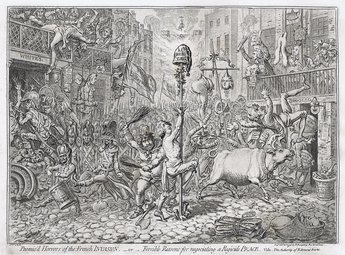Promis'd Horrors of the French Invasion, or Forcible reasons for negotiating a regicide peace.
Only £265.00
Size 44cm x 33cm
Originally published by Hannah Humphrey etched by James Gillray from 'The Genuine Works of James Gillray, engraved by himself. Thomas McLean edition on heavy rag-paper from the original copper plates printed 1830.
French troops march with fixed bayonets up St. James's Street, the houses receding in perspective to the gate of the Palace, which is blazing. In the foreground on the left and right are 'White's' and 'Brookes's'. The former is being raided by French troops; the Opposition is in triumphant possession of the latter. In the centre foreground a 'tree of Liberty' has been planted: a pole garlanded with flowers and surmounted by a large cap of 'Libertas'. To this pole Pitt, stripped to the waist, is tied, while Fox (left) flogs him ferociously, a birch-rod in each hand. Between Fox's feet lies a headsman's axe, bloodstained; on it stands a perky little chicken with the head of M. A. Taylor. On the right is an ox, his collar, from which a broken cord dangles, inscribed 'Great Bedfordshire Ox' (the duke of Bedford); it is tossing Burke, goaded on by Thelwall, who holds its tail, and flourishes a document inscribed 'Thelwals Lectures'. Burke flies in the air, losing his spectacles, and dropping two pamphlets: 'Letter to the Duke of Bedford' and 'Reflections upon a Regicide Peace'.
Behind the ox, Lord Stanhope holds up a pole to which is tied, by a ribbon inscribed 'Vive l'Egalite', the beam of a pair of scales; this is balanced by the body of Grenville, suspended by his breeches, and by his head, suspended by the hair; both drip blood. Stanhope, in profile to the left, looks up with a pleased smile; Lauderdale stands facing him, raising his arm to applaud. Behind is an advancing band of British Jacobins waving bonnets-rouges.
Sheridan, with furtively triumphant smile, enters the door of Brooks's; a large porter's knot on his head and shoulders supports a sack: 'Remains of the Treasury £'; under his arm is another: 'Requisition from the Bank of England'. Beside the door (right) stands a pestle and mortar inscribed 'J. Hall Apothecary to the New Constitution Long Acre'; the mortar is filled with
coronets.
On the balcony above the door, Lansdowne, with his enigmatic smile, is working a guillotine; his left hand is on the windlass, in his right he holds up (towards Erskine) Loughborough's elongated wig; the purse of the Great Seal is attached to a post of the guillotine. On the left corner of the balcony rests a dish containing the heads of (left to right) Lord Sydney, Windham, and Pepper Arden, 'Killed off for the Public Good'. Behind stands Erskine, leaning forward and holding up in triumph a firebrand composed of 'Magna Charta', and a 'New Code of Laws'. On the right corner of the balcony four men stand watching the guillotine with quiet satisfaction: Grafton, in profile to the left; Norfolk, clasping his hands, and Derby. Only the hat and eyes of the fourth are visible. In the club windows behind, staring faces are indicated. The lamp beside the door is crowned with a bonnet-rouge. On the door-post a broadside, 'Marsoiles[e] [sic] Hymn', is placed above 'Rule Brit[annia]' (torn). In the street outside and in the foreground (right) is a basket containing the head of Dundas and a set of bagpipes; it is labelled 'To the care of Citizen Horne Tooke'. Beside it lies a bundle of documents labelled 'Waste Paper 2d pr £6'; they are 'Acts of Parliament, Bill of Rights, Statutes.'
The left (east) side of the street is filled with goose-stepping republican soldiers, headed by a grotesque and ferocious officer, a drawn sword in his hand, who strides past the decollated head of Richmond, beside which lies a paper: 'Treatise upon Fortifying the Coast'. A grotesque and dwarfish drummer marches in front (left); on his drum is the cap of Liberty and the motto 'Vive la Liberté'. He is immediately outside the door of White's, up the steps of which French officers with fixed bayonets are pressing; one tramples on a prostrate and bleeding body, another transfixes the throat of a member; behind are the hands of members held up to beg for mercy. Other soldiers have reached the balcony and are using daggers; they push over the bleeding body of the Duke of York, indicated by his ribbon and the dice-box and dice which fall from him. The Prince of Wales falls head first, the Duke of Clarence is about to be stabbed. From a projecting lamp-bracket beside the door hang the bodies of Canning and Hawkesbury, tied back to back. Their identity is shown by a placard: 'New March to Paris by Betty Canning (an allusion to Elizabeth Canning, convicted of perjury) & Jenny Jenkison'. The (broken) lamp is surmounted by a broken crown. On the club steps and in the street lie a broken 'EO' (roulette) board and playing-cards. The street is filled with close ranks of French soldiers, except for the small body of British Jacobins on the right. 20 October 1796
 View Account
View Account
